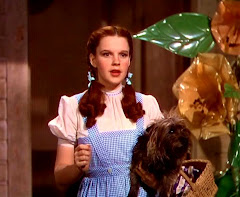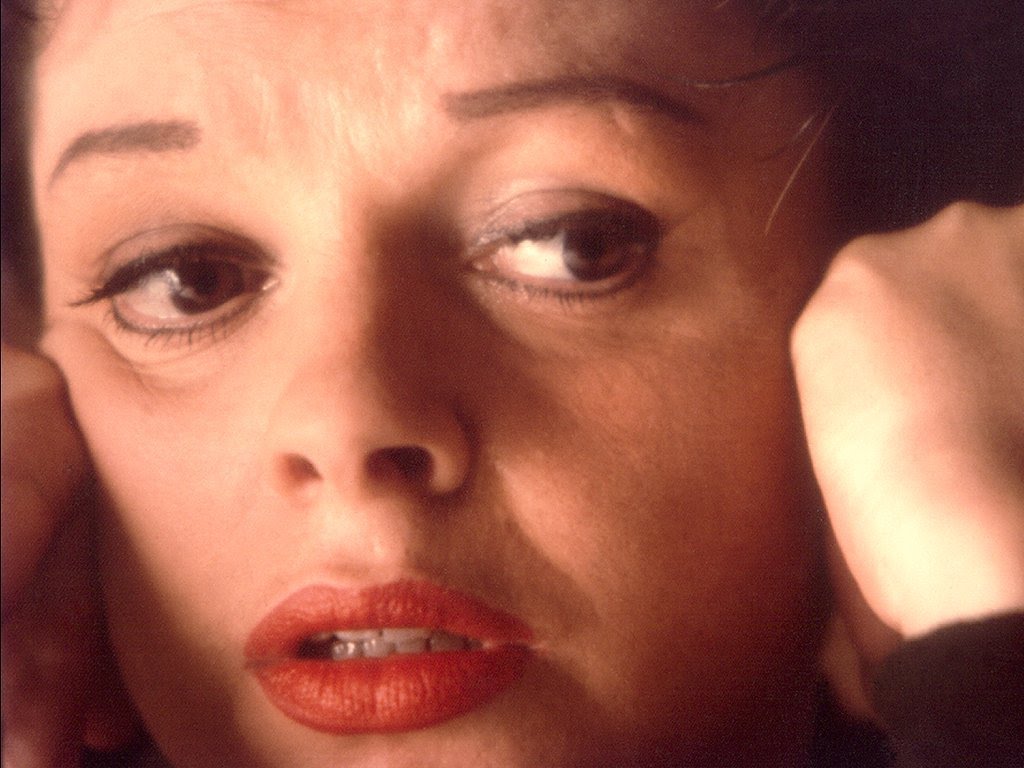
By WILL FRIEDWALD
Judy Garland's gifts as a singer and an actress were fueled by one central talent: her ability to want—or, more specifically, to make the whole world want and dream along with her. Whether it was pining for the man who got away, the boy next door who ignored her, the guy who hadn't shown up yet at all, or longing for a safe place beyond trouble and dysfunction (even if she had to go over the rainbow to find it), no one else could convey so convincingly and overwhelmingly the idea of desperately needing something to complete oneself, be it another person or a bagful of heart, brains and nerve.
Judy Garland's gifts as a singer and an actress were fueled by one central talent: her ability to want—or, more specifically, to make the whole world want and dream along with her. Whether it was pining for the man who got away, the boy next door who ignored her, the guy who hadn't shown up yet at all, or longing for a safe place beyond trouble and dysfunction (even if she had to go over the rainbow to find it), no one else could convey so convincingly and overwhelmingly the idea of desperately needing something to complete oneself, be it another person or a bagful of heart, brains and nerve.
Garland's first recordings—made in March 1935 and now released commercially for the first time in "Lost Tracks," a new boxed set from England—show that she had this rare gift to project her emotional neediness to an entire audience before she was even a teenager. What's more, the discovery of these tracks, essentially lost for 75 years, represents a similar culmination of the hopes and dreams of several generations of fans and collectors.
The first media gatekeeper to take note of the precocious youngster (1922-1969) was Joe Perry, a producer for the newly formed Decca Records label in Los Angeles, who heard The Garland Sisters (previously known as The Gumm Sisters) in vaudeville. Perry was enraptured by the youngest of the trio, and arranged for her to record three tracks (accompanied by her mother on piano): "Moonglow" (which remains lost), "Bill," and a medley of three quick choruses of three contemporary hit songs that were frequently heard on the radio at the time.
For all of Perry's enthusiasm, he failed to convince Decca to "green light" Garland at this early stage. It wasn't until the fall of that year, after she signed with MGM Pictures and began broadcasting regularly (some of those early airchecks are on the new set), that the label made another session with her. In the meantime, Decca's own copies of the March 1935 audition discs were never heard from again—the company sacrificed them (along with the tracks from Garland's second test session in November 1935) to a scrap drive during World War II.
But the singer herself apparently kept a set, which surfaced in 1960 after she moved out of her house in Holmby Hills, Calif. A demolition outfit was cleaning out the vacated premises and, for whatever reason, a worker for that company invited two of his neighbors, Leonard Ferris and his sister Dorothy, to take a look—presumably for the thrill of checking out the former residence of a living legend. It was then that Dorothy Kapano unearthed two of the three discs in a pile of Garland's garbage. Lawrence Schulman, who compiled and annotated the new set, details Ms. Kapano's 50-year effort to determine exactly what these discs were and what should be done with them. Eventually, Mr. Schulman brought the discs to the attention of JSP Records and made them the centerpiece of the "Lost Tracks" package.
The two surviving discs were well worth the effort—for what they tell us about what Garland would become and what she already was. The medley is promising: she sings a children's song, "On the Good Ship Lollipop"; a popular quasinovelty, "The Object of My Affection" (which she comically overenunciates in the manner of an affected radio tenor); and the 1925 jazz standard "Dinah." The last finds her experimenting with a hodgepodge of "hot" techniques, including growls, blue notes and scat singing, gleaned from such influences as Ethel Waters, Louis Armstrong and Bing Crosby. This would never be her forte (even as an adult, her occasional attempts to "swing" would always sound rather forced), but it's still incredible coming from a 12-year-old.
The money number is Garland's amazing performance of "Bill" from "Show Boat." By the very act of singing it, Garland was deliberately evoking the archetypal torch song and the archetypal torch singer, Helen Morgan. The youngster tackles all the verses and choruses—it's a long and tricky song, written for an experienced theatrical singer—with remarkable confidence, and very comfortably shifts gears between the formality of Jerome Kern's quasioperatic style and her own more intimate approach.
After the first chorus, she even directly speaks a few lines of the song, anticipating her famous monologue in the middle of "You Made Me Love You" of 1937. But even the longer spoken section is less remarkable than the ending. As written by P.G. Wodehouse and Oscar Hammerstein, at the coda of "Bill" the character sings "I love him, because he's . . ." and then pauses, becoming so overcome with emotion that she can't think of the words, and just sings "I don't know. . . ." The way it was written for Morgan, the brilliant singer-actress more or less sighs on pitch. Garland, contrastingly, simply says those few words the way a prepubescent girl would. She instantly switches from being a character in a musical to being herself, and it's a miraculous transformation—it's the entire artistic future of Garland, and every diva who came after her, in three tiny words. In Garland's universe, "Bill" would be the very first boy next door who got away.
The rest of the four-CD set—100 tracks total—is well worth owning. The first three discs otherwise consist of radio performances from 1935 to 1953; the last volume is a fascinating assemblage of live concert cuts as well as three prehistoric talkie soundtracks by the Gumm Sisters trio recorded in 1929. The guest stars are also major assets: Garland duets with Crosby, Frank Sinatra and even Al Jolson, and there's also a superb reading of her signature, "Over the Rainbow" accompanied by composer Harold Arlen on piano, a milestone if ever there was one. Even so, nothing astonishes more than that 1935 "Bill," which shows that even at age 12, Judy Garland was already larger than life.
Mr. Friedwald writes about music for the Journal.
The first media gatekeeper to take note of the precocious youngster (1922-1969) was Joe Perry, a producer for the newly formed Decca Records label in Los Angeles, who heard The Garland Sisters (previously known as The Gumm Sisters) in vaudeville. Perry was enraptured by the youngest of the trio, and arranged for her to record three tracks (accompanied by her mother on piano): "Moonglow" (which remains lost), "Bill," and a medley of three quick choruses of three contemporary hit songs that were frequently heard on the radio at the time.
For all of Perry's enthusiasm, he failed to convince Decca to "green light" Garland at this early stage. It wasn't until the fall of that year, after she signed with MGM Pictures and began broadcasting regularly (some of those early airchecks are on the new set), that the label made another session with her. In the meantime, Decca's own copies of the March 1935 audition discs were never heard from again—the company sacrificed them (along with the tracks from Garland's second test session in November 1935) to a scrap drive during World War II.
But the singer herself apparently kept a set, which surfaced in 1960 after she moved out of her house in Holmby Hills, Calif. A demolition outfit was cleaning out the vacated premises and, for whatever reason, a worker for that company invited two of his neighbors, Leonard Ferris and his sister Dorothy, to take a look—presumably for the thrill of checking out the former residence of a living legend. It was then that Dorothy Kapano unearthed two of the three discs in a pile of Garland's garbage. Lawrence Schulman, who compiled and annotated the new set, details Ms. Kapano's 50-year effort to determine exactly what these discs were and what should be done with them. Eventually, Mr. Schulman brought the discs to the attention of JSP Records and made them the centerpiece of the "Lost Tracks" package.
The two surviving discs were well worth the effort—for what they tell us about what Garland would become and what she already was. The medley is promising: she sings a children's song, "On the Good Ship Lollipop"; a popular quasinovelty, "The Object of My Affection" (which she comically overenunciates in the manner of an affected radio tenor); and the 1925 jazz standard "Dinah." The last finds her experimenting with a hodgepodge of "hot" techniques, including growls, blue notes and scat singing, gleaned from such influences as Ethel Waters, Louis Armstrong and Bing Crosby. This would never be her forte (even as an adult, her occasional attempts to "swing" would always sound rather forced), but it's still incredible coming from a 12-year-old.
The money number is Garland's amazing performance of "Bill" from "Show Boat." By the very act of singing it, Garland was deliberately evoking the archetypal torch song and the archetypal torch singer, Helen Morgan. The youngster tackles all the verses and choruses—it's a long and tricky song, written for an experienced theatrical singer—with remarkable confidence, and very comfortably shifts gears between the formality of Jerome Kern's quasioperatic style and her own more intimate approach.
After the first chorus, she even directly speaks a few lines of the song, anticipating her famous monologue in the middle of "You Made Me Love You" of 1937. But even the longer spoken section is less remarkable than the ending. As written by P.G. Wodehouse and Oscar Hammerstein, at the coda of "Bill" the character sings "I love him, because he's . . ." and then pauses, becoming so overcome with emotion that she can't think of the words, and just sings "I don't know. . . ." The way it was written for Morgan, the brilliant singer-actress more or less sighs on pitch. Garland, contrastingly, simply says those few words the way a prepubescent girl would. She instantly switches from being a character in a musical to being herself, and it's a miraculous transformation—it's the entire artistic future of Garland, and every diva who came after her, in three tiny words. In Garland's universe, "Bill" would be the very first boy next door who got away.
The rest of the four-CD set—100 tracks total—is well worth owning. The first three discs otherwise consist of radio performances from 1935 to 1953; the last volume is a fascinating assemblage of live concert cuts as well as three prehistoric talkie soundtracks by the Gumm Sisters trio recorded in 1929. The guest stars are also major assets: Garland duets with Crosby, Frank Sinatra and even Al Jolson, and there's also a superb reading of her signature, "Over the Rainbow" accompanied by composer Harold Arlen on piano, a milestone if ever there was one. Even so, nothing astonishes more than that 1935 "Bill," which shows that even at age 12, Judy Garland was already larger than life.
Mr. Friedwald writes about music for the Journal.














